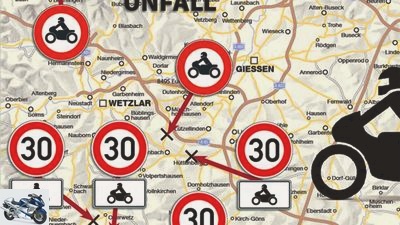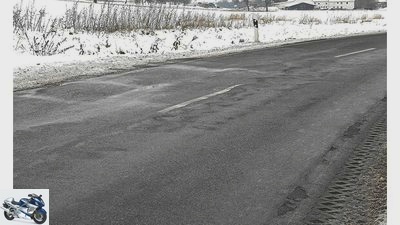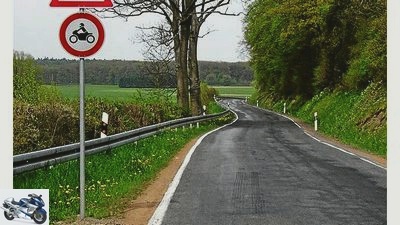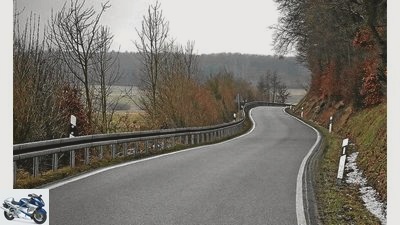Table of contents

Drawing: Werel
counselor
traffic & business
Report: route closures
Report: Line closures in Hessen
Motorcycling prohibited!
Eight years after the tragic death of a motorcyclist, authorities are taking action – by blocking routes. The logic: Anyone who drives and falls is your own fault. Only new roads could remove the lurking dangers. When will it exist??
Michael Schumann
01/06/2011
The prohibition signs came practically overnight. It had just come to spring and Wolfgang Romig was looking forward to the first tours with his Honda XBR 500 when the professional driver from Hessen suddenly discovered that he almost never got out of his village on his motorcycle: “Suddenly the streets were closed to motorbikes all around. Just like that, without notice. If I wanted to go to work on my bike, I would have had to make a detour of 20 kilometers.” Like Wolfgang, it was the same for many motorcyclists in Hesse last spring, specifically in the Limburg, Dillenburg, Gieben, Wetzlar area. Went and went. Because despite local protests by those affected, the closings either remained in place throughout the year or were often converted into 30 km / h speed limits – only for motorcycles, and on some of the heavily trafficked county and country roads.
The roads affected, as MOTORAD has convinced itself, are in a miserable condition across the board. Either heavy traffic has pushed the pavement together in corners to form regular waves, or the asphalt consists only of a bumpy stretch that has been repaired many times. Usually, additional signs also warn of the risk of slipping and skidding – warnings that apply to all road users. However, there are usually no speed restrictions for cars and trucks, cars and trucks have free travel: 60, 80 or even 100 km / h – you can drive whatever is possible. But that’s exactly what motorcyclists think isn’t possible. “Every truck drives you to clump when I’m on my XBR at the age of 30”, fears Wolfgang Romig. “For me it is not understandable what that is supposed to mean.”
Flashback. Same region, eight years earlier. On April 27, 2002 Harry Leugner slipped at 50 km / h on a stretch of country road which, according to a report that was subsequently drawn up, was wet “the grip of a damp steel rail” has gone, the rear wheel of his BMW. Denier slips away on a straight but wet track when braking with his R 1100 GS, crashes into the opposite lane, is hit by a car and succumbs to his internal injuries. At this point in time, the responsible authorities had long been aware of the poor condition of the road. Not just because there had been other accidents in the same place before. There were also reports from the road maintenance department in charge, and the Hessian highway 3053, on which the fatal accident occurred in 2002, had been under the keyword in MOTORRAD’s bitumen database since 2001 “absolute danger” listed.

archive
Asphalt with draped folds: Cars and trucks have free travel here, but motorcyclists can use a speed limit of 30.
The Hessian Higher Regional Court finally found that Harry Leugner’s tragic death was not his fault. The court could not find any driving errors by the 38-year-old father of a one-and-a-half-year-old son. At the end of 2009, seven years after the accident, the court awarded widow Steffi Leugner and Max, who is now ten years old, compensation for pain and suffering in the amount of 15,000 euros and a half-orphan’s pension, referring to the responsibility of the authorities responsible for maintaining a safe road condition. And that is exactly what this judgment has now startled and prompted action.
That brings us back to the here and now. Specifically in the area of the Office for Roads and Transport (ASV) Dillenburg, in which the accident section of Landstrasse 3053 is also located (see map in front). This office – almost eight years after the accident, but only a few weeks after the judgment described above became known – initially completely closed 13 sections of the route for motorbikes, including around Wolfgang Romig’s place of residence. Later in the year, the closure for eleven sections will be converted to 30 km / h, two will remain. But even in the adjacent Main-Kinzig district, for which ASV Gelnhausen is responsible, ten stretches are suddenly closed to motorcycles.

archive
Immediately after the tragedy in 2002, the life-threatening route was closed.
The temporal connection between the blockages and the failed appeal by the state of Hesse before the Frankfurt Higher Regional Court, which was found guilty of the negligent homicide of Harry Denier, is no coincidence. This is not only confirmed by the head of the district regulatory authority of the Lahn-Dill district, Reinhard Strack-Schmalor. His office is responsible for maintaining and maintaining the district roads. The country roads, on the other hand, are a matter for the federal states and as such go to the respective offices for roads and transport (ASV). Marco Grab, spokesman for ASV Dillenburg, confirms: “The ruling has raised awareness. After all, in the opinion of the court, the measures taken at the time were not sufficient.”
Sufficient for what? To prevent accidents like Harry Denier’s, obviously not. That could only have brought about a fundamental and therefore expensive renewal of the ailing roadway, which only consisted of bitumen, mirror-smooth when wet, with no discernible split. The renewal took place in 2002, four months after the accident.
The current closures and speed limits certainly have one effect: If something happens again, it is definitely the fault of the motorcyclist who was either driving too fast, namely at more than 30 km / h, or was not allowed to drive the road at all.

archive
Only after the accident was it considered to renew the above route.
The authorities in Hessen have now stolen their responsibility for the possible consequences of the sometimes miserable road conditions for an entire motorcycle season. A responsibility that has only just been re-confirmed by the court in connection with the death of Harry Leugner, namely in December 2010. In Wetzlar, the former head of the road maintenance department, in whose area of responsibility the BMW driver had died in 2002, was sitting in the dock. After the civil law ruling in Frankfurt, the public prosecutor had brought charges against him in order to now, shortly before the statute of limitations, also name a guilty party under criminal law. Without success. The man could not prove, but at least credibly demonstrate, that he had repeatedly warned those responsible in the police force and in the country of the impending danger. But nothing had happened. Until the accident happened. The case against him has been dropped. In the reasoning, the judge spoke of one on the one hand in connection with Denier’s death “Life risk”, looked however on the other hand “the responsibility” above the road maintenance department, namely “at the higher and the next higher level, too”, speak in administration and politics. But there is “criminal prosecution difficult or impossible”.
So no one will be held personally responsible for Harry Denier’s death. But perhaps the death of the motorcyclist should not remain completely meaningless and without consequences. Because as far as the closed and speed-limited routes in the region are concerned, there is at least a glimmer of hope for 2011. For some of the affected district roads, the chief officer Strack-Schmalohr announces the necessary “thorough renovation plus a large number of surface repairs” an – four million euros are currently provided by the Lahn-Dill district’s current budget planning for this at any rate. Marco Grab from the Dillenburg office, which belongs to the state of Hesse, is less optimistic, as the so-called “Building contractor” is responsible for the maintenance of the country roads: “It is quite possible that roads will be in need of improvement for a longer period of time.” After all, he doesn’t rule out that “Restrictions can also be withdrawn”, since these are immediate measures, the permanent necessity of which is currently still being examined. In addition, the office with the police and the ADAC “in conversation”.
The office, which is subordinate to the state of Hesse, could not even issue permanent closures or speed limits. Because that is the responsibility of the district, whose head of the public order department, Strack-Schmalohr, has a very clear position: “We do not take part in the case of blocks without a recognizable end.” So they have to be lifted in the medium term. But what comes next? “It depends on the individual case”, explains Strack-Schmalohr. “It is our turn to make assessments here in all cases. Whereby traffic safety has priority. We know that there are always two sides to a speed limit.” On the one hand it should serve security, on the other hand it should take responsibility out of those who say it. Just: “Such a restriction cannot be permanently pronounced for a specific group of road users. Ultimately, we are trying to make the country responsible for doing its job.” Specifically: The state of Hesse must finally pay for the renewal of its country roads. Hopefully it will soon.
Related articles
-
Driving report Ducati SuperSport 950 S (2021)
News 2022 New motorcycle items for 2022 Ducati 12th pictures Ducati 1/12 Ducati used the Euro 5 changeover not only to meet technical standards, the…
-
Demos against route closures: Motorcyclist demos on July 4th
Motorcycle noise Debate about the volume of motorcycles Angelina reader 13th pictures Werner Schneider 1/13 Motorcycle demo on July 4, 2020 in Munich:…
-
motorcycles Report: 200 hp limit Report: 200 hp limit Either way? It seems certain that it will fall. When ?? one can speculate about this. And what kind…
-
Driving report: Honda CRF 450 R
motorcycles Enduro Driving report: Honda CRF 450 R Driving report: Honda CRF 450 R well finally The waiting is over. Much later than expected, Honda…
-
motorcycles Driving report Ruko V 1000 SC Driving report Ruko V 1000 SC Total work of art The idea, construction, design and the craftsmanship of the…
-
Driving report Kawasaki ZRX 1200 S and ZR-7 S
motorcycles Driving report Kawasaki ZRX 1200 S and ZR-7 S Driving report Kawasaki ZRX 1200 S and ZR-7 S Partly cheerful With the ZRX 1200 S, Kawasaki is…
-
Artist to travel Stefan Kaschel’s home route Stefan Kaschel’s home route Keep in a hurry: Stuttgart-Herford For all commuters who find 500 kilometers…
-
Screwdriver report – Harley-Davidson for 2000 euros
Schellhorn Photography 27 pictures Schelhorn Photography 1/27 Lutz wanted something dirty because he had planned a major overhaul anyway. And it was…
-
Yamaha XSR 125 driving report: adult retro bike
Yamaha motorcycles Modern Classic Yamaha XSR 125 driving report: adult retro bike Yamaha XSR 125 in the driving report Adult retro bike Yamaha is now…
-
Yamaha Tracer 700 in the HP driving report
Yamaha 28 pictures Yamaha 1/28 Yamaha Tracer 700 in the HP driving report. Yamaha 2/28 Yamaha Tracer 700 in the HP driving report. Yamaha 3/28 Yamaha…